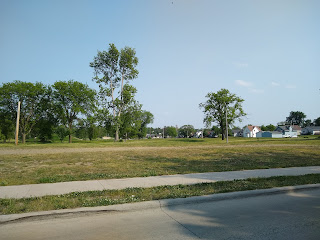 |
| (Source: clipartpanda.com) |
Community land trusts are typically described as an answer to gentrification-fueled displacement: In the words of M. Nolan Gray (2022: 172), "How can we enjoy the benefits [increased investment, better services] of this type of neighborhood change, without all the costs [rents and real estate taxes becoming unaffordable for current residents]?" In theory, I think the same approach could be used in places needing to increase affordable housing stock in the absence of a strong push from gentrification (Cedar Rapids, northeast Iowa), but I think it would be more difficult. CLTs, at least the ones I've read about, survive by capturing some of the increased investment brought by gentrification; in the absence of such an influx, the CLT would have to be funded by private grants and/or government funding.
In 2019, there were 225 CLTs in the United States, containing 20,000 rental units and 15,000 privately-owned homes (Fannie Mae). Usually, cities use some of the additional tax revenue generated by gentrification to provide seed money for the trust, which acquires property that may or may not have existing housing. The trust uses its property to build or rehab housing, which it then sells to low- or moderate-income buyers, while the trust retains ownership of the land. Part of the deal is that the new home owners can sell their house only to another low- or moderate-income buyer. Cities can also give CLTs first-crack at city-owned land, like the swath of vacant property along the Cedar River in Cedar Rapids created by buyouts after the 2008 flood.
 |
| Used to be a working class neighborhood: view from 17th Avenue SW, soon to be developed |
(I don't know if Cedar Rapids has contemplated a CLT; I certainly haven't heard of such an effort.)
 |
| NewBo Lofts, 16th Avenue SE |
Other models are for cities to reserve a portion of tax-increment financing to subsidize affordable housing (for the Portland OR case see Cortright 2019), or funding a non-profit community development commission (CDC) to raise public and private money to fund housing. San Francisco's Mission Economic Development Agency was founded in 1973 for business development but got into real estate 2014 to combat displacement of low/moderate-income Latinos. The agency acquired 400 units when San Francisco sold off public housing, and since ahs been deriving income from developer fees as well as grants (Abello 2018).
 |
| Ribbon cutting at 2828 16th St (source: medasf.org) |
The Greater Cedar Rapids Community Foundation sounds like a CDC, though they don't call themselves one, and their major initiatives at this time don't include housing.
Capturing a share of the increased valuation of real estate in one of these ways is seen as more effective than achieving affordable housing via incentives to or mandates on developers (known as inclusionary housing; the cite I have is Hamilton 2019 from the libertarian Mercatus Center, but I think this point of view is pretty widespread).
Community land trusts have received positive press in Houston (Kimble 2020) and Oakland (Reynolds 2018). Reynolds quotes Steve King, the executive director of Oakland CLT, to the effect they've done good things but it's been a drop in the societal bucket: Certainly we have had a significant impact for the folks we've already worked with, but in terms of us impacting the ownership and control of land in Oakland, we have a long way to go.
 |
| house available through OakCLT |
I have seen citations for, but not reviewed, research that suggests:
- the success of CLTs (and CDCs) varies widely based on funding base and effective management (Nathaniel S. Wright, "Transforming Neighborhoods: Explaining Effectiveness in Community-Based Development Organizations," Journal of Urban Affairs 40:6 (2018), 805-823)
- CDCs are criticized for working within rather than challenging the economic status quo (Mark C. Chupp, "The Long-Term Impact of CDCs on Urban Neighborhoods: Case Studies of Cleveland's Broadway-Slavic Village and Tremont Neighborhoods," Community Development 37:4 (2006), 3-52; Neal Pierce, "An Urban Agenda for the President," Journal of Urban Affairs 15 (1993), 457-467)
- CLTs have received the same criticism (James DeFilippis, Brian Stromberg, and Olivia R. Williams, "W(h)ither the Community in Community Land Trusts," Journal of Urban Affairs 40:6 (2018), 755-769)
Other research I've seen cited but haven't read:
Jeffrey S. Lowe and Emily Thaden, "Deepening Stewardship: Resident Engagement in Community Land Trusts," Urban Geography 37:4 (2015), 611-628
Myungshik Choi, Shannon Van Zandt and David Matarrita-Cascante, "Can Community Land Trusts Slow Gentrification?" Journal of Urban Affairs 40:3 (2017), 394-411
SOURCES
M. Nolan Gray, Arbitrary Lines: How Zoning Broke the American City and How to Fix It (Island, 2022)
Allan Mallach, The Divided City: Poverty and Prosperity in Urban America (Island, 2018) [I haven't read it... among other comments on housing, he criticizes CDCs for achieving results in high-poverty areas but not in less concentrated areas where poor people can connect to better jobs and schools]
On gentrification in Texas: Yichen Su, "Gentrification Transforming Neighborhoods in Big Texas Cities" (Q4 2019), https://dallasfed.org/research/swe/2019/swe1904/swe1904b
OTHER THINGS I'VE WRITTEN:
"What We Can Do About Housing," 18 March 2022 [based on talk by Jenny Schuetz, author of Fixer Upper: How to Repair America's Broken Housing Systems (Brookings, 2022)]
"Housing Policy," 1 July 2021 [more general overview by issues of (1) affordability/supply, (2) connections, (3) gentrification/stability]




No comments:
Post a Comment